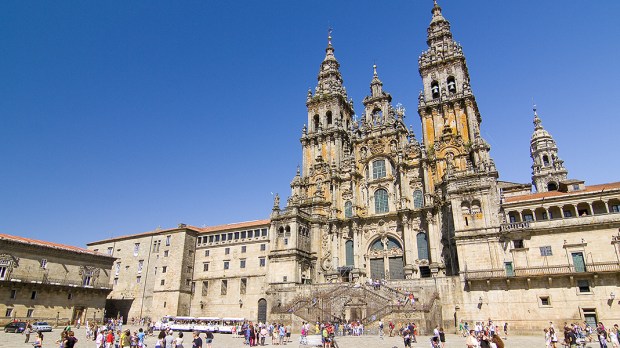Historians have been tickled by the discovery of a small, 11-inch carving of a little man found on a capital stone in the Spanish cathedral of Santiago de Compostela, the final stop along the famed Camino de Santiago pilgrimage. Believed to be a self-portrait of the unnamed stonemason who helped carve the fine art throughout the cathedral, this figure has remained hidden in a darkened corner of the building for centuries, like a difficult page of a Where’s Waldo puzzle book.
The carving has been there since the cathedral was constructed, in the year 1211, but it may have gone unnoticed by the millions of pilgrims who have visited Santiago de Compostela for more than 800 years. According to The Guardian, art historian Dr. Jennifer Alexander only happened upon the hidden work of art while conducting a stone-by-stone analysis to work out the church’s construction sequence. As she described it, the image of the little man “popped out” at her. She said:
“A lovely image of a chap hanging on to the middle of the capital as if his life depended on it. It’s in a row of identical off-the-peg capitals where they’ve been knocking them out in granite – ‘we need another 15 of that design’ – and suddenly there’s one that’s different. So we think it’s the man himself.” She added, “He emerges out of the capital and is clinging to it. It’s almost as if it’s swallowing him up.”
This carving has been hiding in plain sight for 900 years and millions of people who visited the beautiful Cathedral Santiago De Compostela haven’t seen it. The carving of this man was there all along, but it was never meant to be seen. #Spain#Ancienthttps://t.co/83lTqy70oZ
— Ancient Pages (@AncientPages) November 2, 2020
While it is believed that this figure represents an image of the stonemason who carved it, the identity of this mysterious little man remains unknown.Smithsonian Magazine explains that “signing” one’s work in such a way was an honor reserved for only the most renowned and skilled stonemasons, while the vast majority of stonemasons generally remained anonymous. The hidden nature of this medieval “selfie” suggests that the sculptor did not qualify for such a privilege, but found a way to immortalize himself nonetheless.
While the identity of this trickster stonemason may never be revealed, the self-portrait will remain in the Basilica of Santiago de Compostela, suspended 13 feet above the ground. Alexander told the Guardian:
“It’s just such a charming connection between us and the person that carved it. It’s almost as if it was designed just for us to see it by those people working on the building. Of course, this stonemason probably had no idea that he’d have to wait so long to be spotted.”

